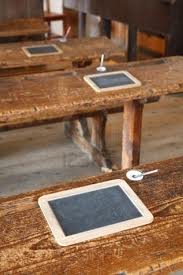Reverse The Presentation!

For the longest time we’ve been teaching with our backs to children. It may have started when the individual chalk slates were taken away from kids upon leaving the one-room schoolhouse for the larger normal schools. With only one writing board for sharing in the class, it became easier, out of necessity, to turn our backs on students. It also became easier to get comfortable doing it. So the transition to digital technology followed that lead.
There may have been a short side trip from the front board to facing the class, when the overhead projector was dragged from the bowling alley. I know that a lot of math teachers loved that. Lights turned off, sitting with a sloppy ink marker, facing the captive eyes-glazed audience—and every-so-often blinded by the light, and scorched by the bulb heat—making a plastic-wrapped point. Some teachers, used to correcting homework all class kicked and screamed when overheads became obsolete—and many hoarded them. I’m certain a few are still hidden away, out of the tech director’s reach in some classrooms—sneaked out as a comfortable choice. What’s left of the surplus bulbs can’t burn out fast enough for me.
Then came the whiteboards, I’m sure seen by some as a way to get teachers back on their teaching feet. The adjective to describe them was “interactive”, but it’s still used as an electrified, digitized chalkboard in many instances. There is no getting around the fact that they, again, turn teaching backs to students. Multi-touch software and slate controls, similar to a remote mouse, can operate whiteboard tools, making it possible to get more students involved—a little—but not in a complete way—in their own learning. The root of the problem is that whiteboards, just like their chalkboard predecessors don’t present in the right direction for today’s digital, handheld students.
So, it’s time for someone to shout a bit. We are looking at teaching and presenting lessons in an archaic delivery way. We need to reverse the teaching method for presenting. Handheld devices are the one-room-schoolhouse slates digitally reincarnated. Stand quiet for a moment and you can almost hear the iPad program startups in our schools beginning, not to mention those of other digital devices being fired up daily at students’ seats. That’s where we should be presenting—to those devices—not to the static board in front of the classroom. Even the best whiteboard presentations lack the potential to be great, full-bodied, memorable and encompassing lessons. Most are presented in dimly lighted rooms, and from the shadows. Interactive at the front of the room is stagnant, but presentations that are projected to a classroom audience with tablets, netbooks, or other held in-the-hand devices create opportunities for active students rather than passive ones. It may be possible to engage 100% of a classroom all the time, rather than just a few students some of the time—each class period. Now that’s really “Flipping” a classroom in the right direction. Reverse the presentation!
Ken Royal is a teacher/education and education technology blogger/reporter, video interviewer, podcaster, education event news commentator with 34 years of classroom/school and instructional technology experience. His teaching accomplishments include: 4-time district teacher of the year, Connecticut Middle School Teacher of the Year, and Bill and Melinda Gates award for Technology School of Excellence. Read more of Ken’s work at Royal Reports.
Tools and ideas to transform education. Sign up below.
